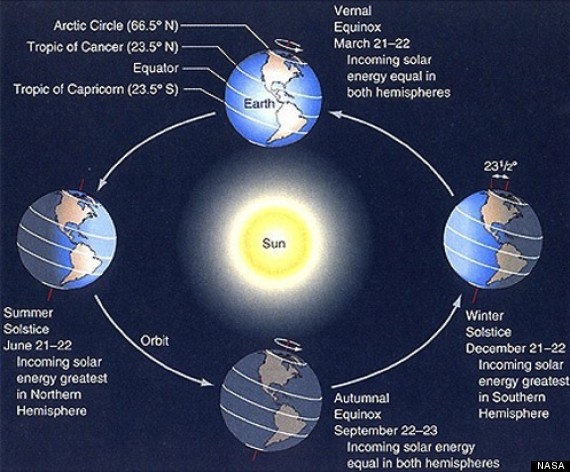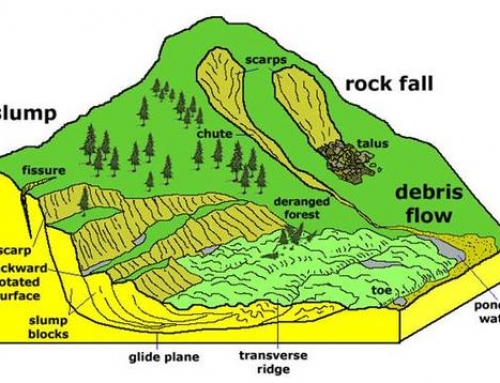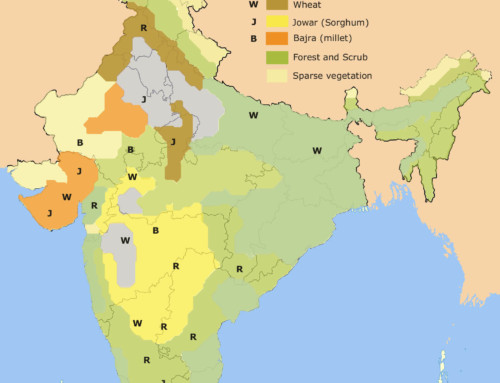The Earth shows two types of motions which leads to seasons and day-night patterns. These motion are – rotation around its own axis and revolution about the Sun.
- Rotation – The movement of the earth on its axis. The Earth rotates from the west towards the east. Around 500 BC, Aryabhatta deduced by his calculations that the Earth is spherical and rotates about its axis.
- Revolution – The movement of the Earth around the Sun in a fixed path or orbit is called Revolution.This movement causes seasonal variations in different parts of the Earth. It takes 365 days 6 hours to revolve around the Sun.
Elliptical orbit: The earth moves around the sun in an elliptical orbit.
Inclination of Earth never changes: Throughout its orbit, the earth is inclined in the same direction.

There are a few terms associated with these movements, which are essential for complete understanding of the concepts involved in sesonality and Time descriptions regarding the Earth.
- Circle of Illumination – Earth is spherical in shape,which leads to half of the sphere being exposed to the sunrays at a time and other half being in the dark. As a result of this, one half of Earth experiences Day and another half experiences Night. Now, this circle which divides the day and night on Earth is known as the Circle of illumination. Notably, this circle does not coincides with the Axis of Earth.
- Seasons – Earth is tilted on its axis, this means that different parts of Earth receive different amount of sunlight. Such a situation when
- Earth is tilted with 66 1/2 angle with the Orbital Plane- The axis of the earth which is an imaginary line, makes an angle of 66 1/2 with its orbital plane occurs along with the regular rotation of Earth, causes the occurance of various seasons across the globe. Southern hemisphere receives different season than the Northern hemisphere:
-
On 23rd Sept. it is autumn season in the Northern Hemisphere and spring season in the Southern Hemisphere.
-
The opposite happens on 21st March, when it is spring in the Northern Hemisphere and autumn in the Southern Hemisphere.
-
- Leap year – Six hours are saved every year from the time period of a year. In four years, these are combined to make a day and under the georgian calender , it is added to the February 29. such a year has 366 days compared to the 365 days of normal year.
- Summer Solistice – It happens on June 21st of every year. The Longest day and Shortest night is observed in the Northern Hemisphere. This occurs because the Northern Hemisphere is inclined towards the Sun with the North pole pointing towards the Sun. Therefore, the Sunrays fall directly over the Tropic of Cancer. A large portion of Northern Hemisphere receives light from the Sun, hence it is summer in the regions of this hemisphere. But, in the Southern Hemisphere, the region experiences winter season with longer nights than the days.

- Winter Solistice – This happens on December 22nd of each year. The Northern Hemisphere observes shortest day and Longest Night. Whereas, the Southern Hemisphere experiences Longest day and Shortest night. This happens because the South pole is inclined towards the Sun with the Southern Hemisphere receing maximum sunlight, hence, it is summer season in the southern hemisphere but winter season in the northern hemisphere.This position of the Earth is known as Winter Solistice.
- Equinox – It occurs twice a year. Once on March 21st and again on September 23rd. When direct sunrays fall over the equator, maximum sunlight is received by the equatorial region. This results in equal length of day and night over all of Earth. At this position, none of the poles are tilted or inclined towards the Sun. This is known as Equinox.
- Perihelion – It occurs on January 3rd. While in orbit , when Earth is closest to the Sun, which means then Earth is at minimum distance from the Sun.
- Aphelion – This occurs on July 4th every year. While the Earth orbits around the Sun and is positioned at maximum distance from the Sun, that position is called aphelion.





